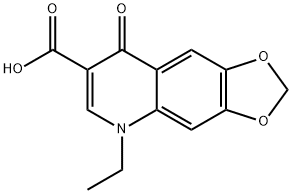
Оксолиновая кислота
- английское имяOxolinic acid
- CAS №14698-29-4
- CBNumberCB8177186
- ФормулаC13H11NO5
- мольный вес261.23
- EINECS238-750-8
- номер MDLMFCD00056775
- файл Mol14698-29-4.mol
химическое свойство
| Температура плавления | 314-316°C (dec.) |
| Температура кипения | 473℃ |
| плотность | 1.3038 (rough estimate) |
| показатель преломления | 1.5500 (estimate) |
| Fp | >110°(230°F) |
| температура хранения | 2-8°C |
| растворимость | Soluble in 0.5N NaOH with warming |
| пка | 5.94±0.20(Predicted) |
| форма | Crystalline Powder |
| цвет | White |
| Растворимость в воде | 3.214mg/L(temperature not stated) |
| Чувствительный | Light Sensitive |
| Мерк | 13,7014 |
| БРН | 620635 |
| Стабильность | Stable. Combustible. |
| ИнЧИКей | KYGZCKSPAKDVKC-UHFFFAOYSA-N |
| Справочник по базе данных CAS | 14698-29-4(CAS DataBase Reference) |
| FDA UNII | L0A22B22FT |
| Код УВД | J01MB05 |
| Система регистрации веществ EPA | Oxolinic acid (14698-29-4) |
| UNSPSC Code | 51282935 |
| NACRES | NA.85 |
больше
| Коды опасности | Xn | |||||||||
| Заявления о рисках | 22 | |||||||||
| Заявления о безопасности | 22-24/25-60-36 | |||||||||
| WGK Германия | 3 | |||||||||
| RTECS | JI5075000 | |||||||||
| F | 10 | |||||||||
| кода HS | 29349990 | |||||||||
| Банк данных об опасных веществах | 14698-29-4(Hazardous Substances Data) | |||||||||
| Токсичность | LD50 in mice, rats (mg/kg): >6000, >2000 orally (Turner) | |||||||||
| NFPA 704: |
|
рисовальное письмо(GHS)
-
рисовальное письмо(GHS)

-
сигнальный язык
предупреждение
-
вредная бумага
H302:Вредно при проглатывании.
-
оператор предупредительных мер
P264:После работы тщательно вымыть кожу.
P270:При использовании продукции не курить, не пить, не принимать пищу.
P301+P312:ПРИ ПРОГЛАТЫВАНИИ: Обратиться за медицинской помощью при плохом самочувствии.
P501:Удалить содержимое/ контейнер на утвержденных станциях утилизации отходов.
Оксолиновая кислота химические свойства, назначение, производство
Описание
Bacterial DNA gyrase is a heterodimeric type II topoisomerase that negatively supercoils circular double-Химические свойства
Crystalline SolidИспользование
Oxolinic acid is a quinolone antibiotic used for studies on DNA winding and coiling and for studies on dopaminergic neurotransmission processes. It is used to study new transmissible resistance mechanisms qnrA, qnrB, qnrS, and aac(6′)Ib-cr, in EscherichiaОпределение
ChEBI: A quinolinemonocarboxylic acid having the carboxy group at position 7 as well as oxo and ethyl groups at positions 4 and 1 respectively and a dioxolo ring fused at the 5- and 6-positions. A synthetic antibiotic, it is used in veterinary medicine for the tr atment of bacterial infections in cattle, pigs and poultry.Антимикробная активность
Like nalidixic acid, this drug is effective with respect to Gram-negative microorganisms and is used for the same indications. Synonyms of this drug are nidantin, prodoxol, ocolin, uroxol, and others.Общее описание
Chemical structure: quinoloneФармацевтические приложения
An oral 4-quinolone with a tricyclic structure. Its antibacterial spectrum is very similar to that of nalidixic acid, but it is more active againstEnterobacteriaceae (MIC 0.25–2 mg/L). Grampositive bacteria, Ps. aeruginosa and anaerobes are resistant.After repeated doses of 750 mg twice daily, mean plasma concentrations are initially very low, but steady state is reached at the third day and Cmax is around 3.5 mg/L. Administration with food delays absorption. Binding to plasma protein is about 80%. It undergoes complex biotransformation, and an enterohepatic cycle may account for the increase in the apparent elimination half-life from 4 to 15 h over 7 days of treatment as well as for the 20% of dose which can be recovered from the feces. About 50% of the dose appears in the urine in the first 24 h, partly in the form of metabolites, some of which display antibacterial activity.
Side effects common to the quinolones occur frequently. About one-quarter of patients treated with 750 mg every 12 h suffer nausea and vomiting or restlessness and insomnia. Its only use is in the treatment of lower urinary tract infections.
Профиль безопасности
Moderately toxic by ingestion. Low toxicity by skin contact. Mutation data reported. When heated to decomposition it emits toxic fumes of NOx.Методы очистки
Purify the acid by recrystallisation from aqueous Me2CO, 95% EtOH or dimethylformamide. It has UV 220, (255.5sh), max 259.5, 268, (298sh, 311sh), 321 and 326nm [ 14.8, (36.8sh), 38.4, 38.4, (6.4sh, 9.2sh), 10.8 and 11.2 x 103]. [Kaminsky & Mettzer J Med Chem 11 160 1968, Beilstein 17 H 6, 17 I 3, 17 II 202, 17 III/IV 13, 17/1 V 11.]Оксолиновая кислота запасные части и сырье
Оксолиновая кислота поставщик
| поставщик | телефон | страна | номенклатура продукции | благоприятные условия | |
|---|---|---|---|---|---|
| +8613573296305 | China | 301 | 58 | ||
| United States | 24072 | 58 | |||
| +8615531157085 | China | 8804 | 58 | ||
| +86 13288715578 +8613288715578 |
China | 12825 | 58 | ||
| +86-13131129325 | China | 5887 | 58 | ||
| +86-17331933971 +86-17331933971 |
China | 2472 | 58 | ||
| +86-18565342920; +8618565342920 |
China | 290 | 58 | ||
| +8618092446649 | China | 1143 | 58 | ||
| +86-18239973690 +86-18239973690 |
China | 311 | 58 | ||
| +8613343047651 | China | 3692 | 58 |